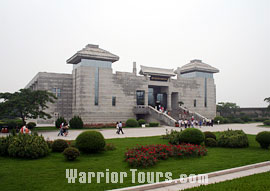- Big Wild Goose Pagoda & Tang Dynasty Palace
- Bell/Drum Tower & Daxingshan Temple
- City Wall
- Forest of Stone Steles Museum & Banpo Museum
- Great Mosque
- Huaqing Hot Springs & Xingjiao Temple
- Mausoleum of the First Qin Emperor
- Mausoleum of Western Han Emperor Liu Qi
- Terracotta Warriors
- Shaanxi History Museum
- Small Wild Goose Pagoda
- Famen Temple & Xianyang Museum
- Maoling Mausoleum & Tomb of Huo Qubing
- Mt. Huashan
- Qian Mausoleum & Zhaoling Mausoleum
Mausoleum of the First Qin Emperor
Emperor Qin Shi Huang (also called Qin Shi Huangdi by westerners or the First Emperor) was the founder of the first unified empire in the history of China. He established an autocratic state with centralized power over the feudal society. Just as the exploits of Napoleon inspire the French, so the Emporer's life, political ambitions, gains and losses are fascinating to the modern world.

![]() Ascent to the Throne
Ascent to the Throne
About 300 years after Sakyamuni, the founder of Buddhism, was born in what is now India, a baby was born in Handan, an ancient town in China. Yingzheng (the name of Qin Shi Huang) led a tough childhood when his father, son of the King of Qin state, was held hostage in the State of Zhao until Lu Buwei, a wealthy merchant secured their release back to the Qin.
Ying Zheng became the King of Qin at the age of 13 upon the death of his father. However, rule was actually exercised by the prime minister Lu Buwei until 238 B. C. when Ying Zheng, then aged 22, assumed control of state affairs and immediately stripped the minister of his powers.
![]() 'Qin Shi Huang'- the Title of the First Emperor in China
'Qin Shi Huang'- the Title of the First Emperor in China
With assistance of wise and innovative men, Ying Zheng carried out a series of reforms to develop agriculture and the military. When Qin defeated the other six states in 221 BC, for the first time in history, all China became a unified empire. Ying Zheng assumed the title 'Shi Huangdi' as he considered his achievement surpassed those of 'San Huang' (three previous emperors) and 'Wu Di' (five previous emperors), legendary rulers in remote antiquity. 'Shi' which means the first, combined with 'Huangdi', the given names of his predecessors signifies his supremacy over them. Although his reign lasted little more than a decade, it had a defining influence on Chinese civilization.
![]() Achievements
Achievements

To organize his new empire, Qin Shi Huang abolished the existing feudal system. He established prefectures and counties with further townships. These were put under the control of military and administrative officials who were his direct appointees.
Roads radiating from Xianyang, the capital, were built linking the former Yan, Qi, Wu and Chu areas. To strengthen the northern border, the Emperor sent slaves and criminals to build the line of defense now known as the Great Wall. He also standardized the script used for writing, the coinage, introducing a circular copper coin with a square hole in the center. Equally important reforms were the standardization of weights and measures, and codification of the law. These reforms benefited both the economy and cultural exchange during the period.
![]() The Decline of the First Emperor
The Decline of the First Emperor
Qin Shihuangdi was apprehensive about the prospect of death. When he ascended the throne in 246 BC. he commissioned the construction of his tomb, work which intensified following conquest of the rival states. The emperor died whileaway from his capital on tour in 210 BC. His demise sparked uprisings across the country and thus the Qin dynasty ended in 206 BC.
A reformer as well as tyrant, Qin Shi Huang, left to posterity his immense and monumental Qin Mausoleum, a creation of both blood and tears.
Page 1 2

